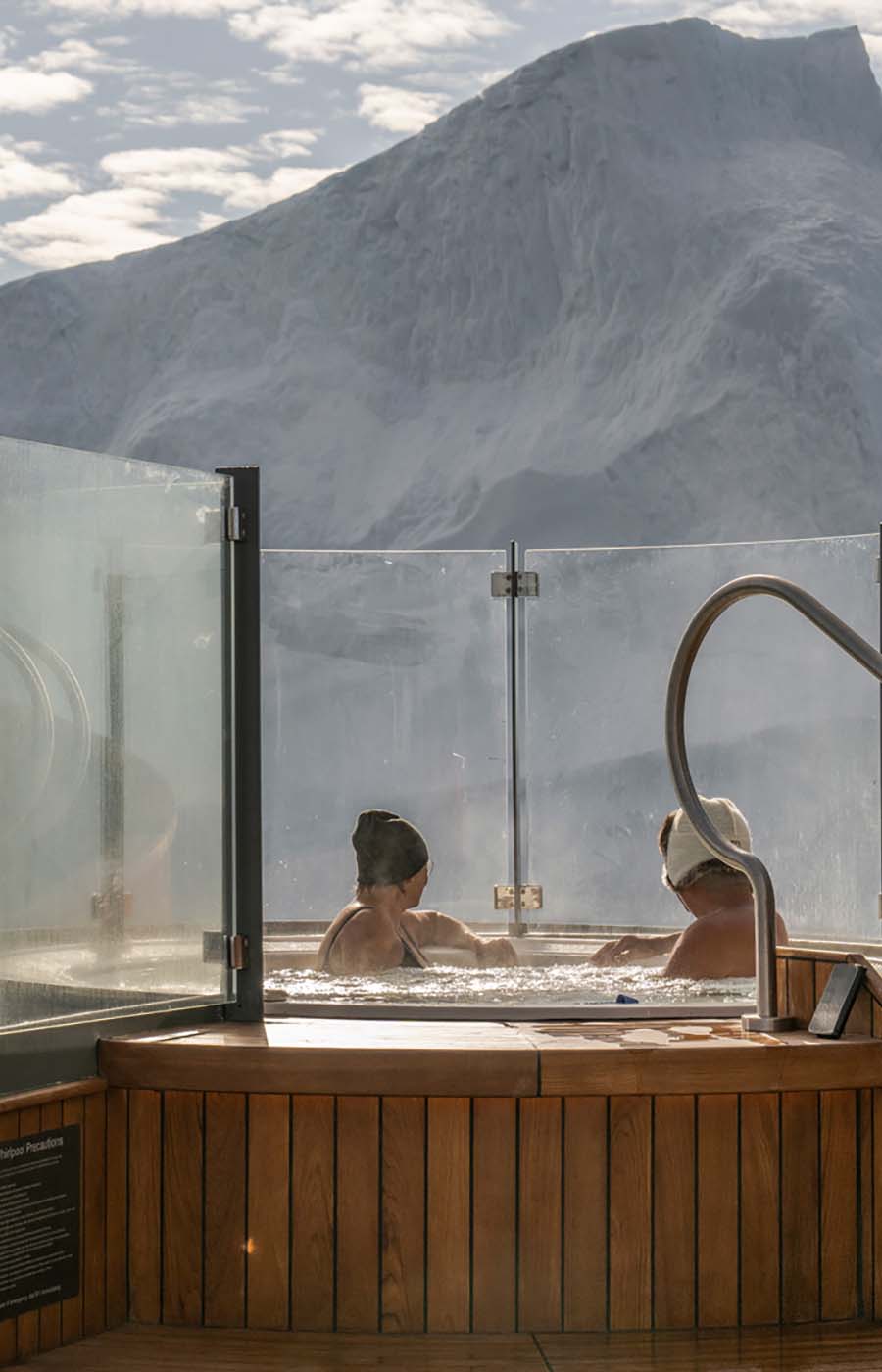The Caribbean's natural wonders were molded by fire, earth and water.
With every footstep comes a splash echoing within the smooth stone walls of the shaded beachside grottos. I’m walking through shallow pools of seawater, twisting and ducking to avoid low rocks within contorted passageways. Around me are massive boulders strewn atop each other, wedged in tightly under the crushing force of unfathomable weight. And when sunlight sifting through cracks in this disjointed jumble of granite accents the water with an aquamarine tint, I realize that longpast volcanic fury has created one of the Caribbean’s most stunning natural wonders.
It’s perhaps a bit ironic that this tranquil and even spiritual setting along one of the British Virgin Islands’ whitesand beaches started with fire and lava. Mighty but beautiful, these grottos known as The Baths formed when seeping molten rock filled holes in softer volcanic rock that eroded over the millennia, leaving the jagged pattern of boulders we see today. And up from the beach on higher ground, the boulders pile high forming a majestic, rocky landscape.
On the western edge of the BVI’s Virgin Gorda, The Baths are just one of the many extraordinary natural wonders shaped by volcanic awe — undersea fire and molten rock — found throughout the Caribbean. From Montserrat’s Soufrière Hills volcano to St. Lucia’s Sulphur Springs known as the “Drive-In Volcano”; from Dominica’s Boiling Lake to Aruba’s volcanic-rock Hooiberg hill and Martinque’s Mont Pelée, Mother Nature has made it clear that when it comes to volcanic activity, She has the final say.
At first glance, Martinique’s violent volcanic history might be hard to imagine. Fields with ripening pineapples and banana trees speckle the green countryside along winding roads through lush rainforests. Tourists flock to beachside resorts along the island’s southern shores. But the northern shores have a different look — dark-sand beaches blackened by volcanic ash.
That’s because along the island’s northwest coast sits Mont Pelée. It was just over a century ago when the now semiactive volcano — its 4,583-foot-high summit often piercing fluffy Caribbean clouds — exploded with a whirlwind of superheated gases and rocks that swept down the mountainside at a few hundred miles an hour. The eruption pulverized nearby Saint-Pierre, then known as the “Paris of the Caribbean,” when it was the French island’s cultural and cosmopolitan capital.
Despite smaller eruptions, tremors and venting gases in the preceding days, curious residents failed to heed those warning signs and flee. The volcanic blast killed 30,000 or more in minutes. Only two miraculously survived — an incarcerated brawler protected from the heat by his dungeon’s thick stone walls, and a girl in a boat who rowed to refuge in a cave.
Today, that jail cell, which dates to 1660, remains near Saint-Pierre’s Musee Volcanologique. The museum displays scorched relics — dramatic reminders from that day — including a melted bell and charred clocks stopped to the minute at 7:52 a.m. when the eruption struck on May 8, 1902. A tourist tram now traverses the streets of the rebuilt city, focusing on the blackened ruins left from the firestorm, including the cathedral façade and a 1786 theater that once seated 800.
From Martinique’s southern shore, you can catch a glimpse of yet another of the Caribbean’s largest volcanic wonders. The Pitons, the twin cone-like peaks along St. Lucia’s rugged southwestern waterfront, dominate the island’s jagged mountainous skyline, fronting the blue waters of Soufrière Bay. The twin peaks are similar in appearance and height; Gros Piton pierces blue skies at 2,619 feet high while the shorter Petit Piton stands at 2,461 feet, although there’s certainly nothing petite about either of these landmarks.
The mountains are covered in verdant tropical vegetation, given a foothold by erosion over the millennia. Their dual cones are actually volcanic plugs formed when lava hardened within vents blown open by the volcanoes that formed the islands 30 to 40 million years ago. Today, visitors can cross another adventure off their bucket lists by hiking up Gros Piton. Although a strenuous climb, trails are more maneuverable than the steeper Petit Piton. The view of the jungle and the sea is magnificent.
Drive just a few miles inland and it takes only a matter of minutes before sulfurous odors waft through the air. They bubble up from more than 20 pools and fumaroles of mud and water, venting steam and volcanic gases against a hilly backdrop. Despite what the name implies, you can’t actually drive directly into this active area, known as both Sulphur Springs and the La Soufriére Drive-In Volcano. But the road is close enough to reach the mineral-painted waterholes on foot.
The area is rippled with underground fractures through which rainwater creeps into the earth and is then heated by volcanic activity. Steaming hot, it shoots back up into wide pools. Because of the constant spewing from underground, sulfur, gypsum and compounds of iron, calcium and copper crust alongside the pools’ rims and trickling streams forming kaleidoscopes of minerals — powdery white, streaks of sulfurous green and yellow and reddish bands from iron oxides. Some of these colorful spots are now popular swimming holes where people flock to soak in the warm natural springs as well as smear mud on their skin, which is thought to be therapeutic.
At a nearby geothermal attraction, Diamond Falls Botanical Gardens and Mineral Baths, similar hot springs were first developed by the French so soldiers under King Louis XVI could recuperate using the water’s therapeutic properties.
Bubbling volcanic magma not only formed beautiful Caribbean natural wonders above ground, but also below ground in the form of sparkling stones that can be polished into rare gems. One of these precious minerals is blue larimar, found exclusively in the Dominican Republic.
“It’s a hard stone, almost like diamonds,” says tour guide Manny Acosta.
A blue variety of silicate quartz pectolite, larimar gets its color from copper compounds dominating its makeup. Also called Stefilia’s stone or Caribbean stone, it’s retrieved from mines where volcanic gases had pushed the gemstones up toward
the surface through volcanic holes or vents in sedimentary layers. Larimar is mined solely outside Barahona, a city in the southwestern region of the country, although sometimes pieces are found along the island’s shores, washed downstream by the Bahoruco River and left in alluvial deposits.
Related Seabourn itineraries and amenities below
When polished, the stone shines in different shades of blue streaked with white minerals and often accented with hints of blue-green and other colors. Jewelers cut larimar chunks into various shapes, often setting them in silver and sometimes gold in rings, pendants, earrings and bracelets. The jewelry is sold in shops in the Dominican Republic and throughout the Caribbean, and samples of all shapes and sizes are on display at the Larimar Museum and Factory in Santo Domingo.
Although first discovered in the early 20th century, larimar became popular when Dominican Miguel Méndez, a U.S. Peace Corps volunteer, found a blue stone washed up on the beach and traced it upstream along the Bahoruco River to the mining area that remains today. Perhaps an even better story is how larimar got its name. “Méndez took the first four letters from his daughter, whose name was Larissa, and added mar, which in Spanish means ‘ocean,’ ” explains Acosta. An ocean, no doubt, that reflects the beautiful and enticing shades of Caribbean blue.

